3 in 1: Discussions, tasks, documentation
Our team employs over 30 people. We develop scalable web solutions. We live in Tomsk, St. Petersburg and in Moscow. To organize collaboration on tasks, we used a task tracker. During the projects, valuable developments were created and it was necessary to organize work with knowledge. We tried various wiki systems. It turned out that most of our knowledge is created when solving current problems. We faced problems:
- It is inconvenient to enter and manage all tasks in a task tracker, and therefore employees all the time go to communicate via instant messengers.
- A lot of knowledge settles in the e-mail and instant messengers. Transferring knowledge from correspondence to a task tracker and wiki takes a lot of time and effort.
- If while planning a project, the entire concept of a project was recorded on a wiki, then every day the differences between the information on the wiki and the real state of affairs become more and more, and the support of the knowledge base becomes unnecessarily time consuming.
Knowledge out of stock
The information flow model is best seen in simplified business processes. Consider a small home appliances store. The shop employs 11 people, there is a pavilion and a warehouse.We depict the business process of order processing, which includes the procedures: ordering, packaging and delivery to the client. The process involves 3 people, the actions of the process are recorded in a specialized information system and occur regularly.
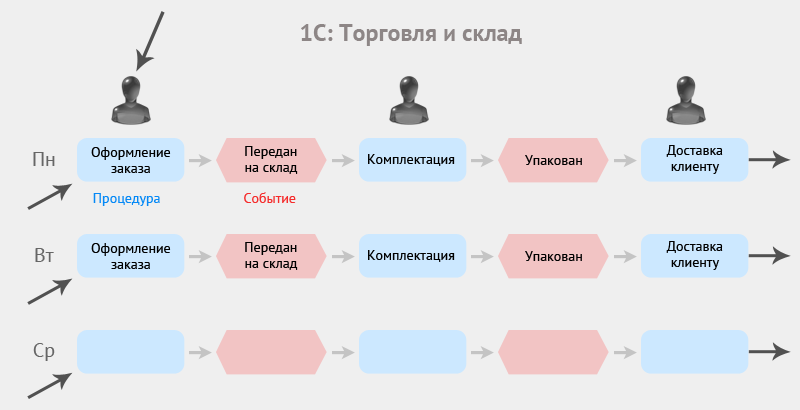
Simplified business process
Other tasks in the organization are occupied by another 8 people, they communicate verbally, in e-mail, instant messengers and in other specialized information systems.
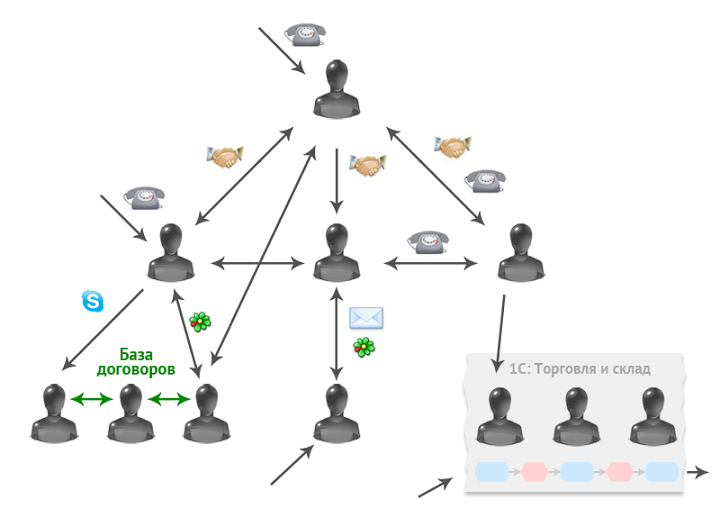
Communication scheme in the hardware store
')
Environment: competitors, suppliers, government agencies, weather, etc. constantly changing. Store managers need to identify these changes and make decisions promptly. Such decisions are discussed and made orally, in e-mail and instant messengers. It is these solutions that allow the store to survive, remain profitable in the long term, and in essence create the value of the business. Most of the valuable knowledge is in the head of the head. There is nothing wrong with this, as long as the company's need for knowledge is small, and as long as the employee remains in the company.
What knowledge can be valuable? In our example, after solving a problem with the appearance of a bad smell from a basement in a warehouse, you can record information about where to call, what to ask, etc.
Air tax
Consider another situation: a distributed IT team develops and implements accounting software. There is a new law "On Air Tax". Accordingly, you need to make changes to the software. The decision may occur in the following order:1. The project manager writes a letter to the programmer describing the situation.
2. A programmer starts a task in a task tracker and writes to the architect: “The application is unusual, you need to clarify the details.”
3. The architect writes to the manager a list of questions that need to be clarified.
4. The manager sends a letter with a detailed description of what is needed.
5. The architect adds the letter to the task tracker.
6. The programmer writes the result of the task in the task-tracker.
7. The programmer makes changes to the architecture of the corporate wiki.
Imagine communication:
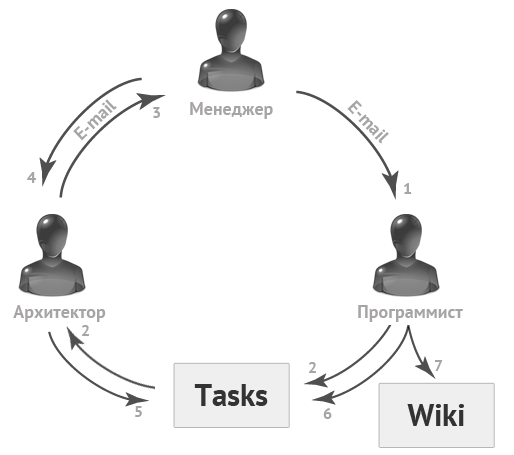
information flows in solving the problem in the IT team
In this example, the ideal case was considered, when all the information was transmitted without loss and distortion, and the result was immediately accepted by the project manager.
In practice, clarifications are often necessary, and, most likely, all three will communicate on the task in the messenger. These specifications contain knowledge. As a result, most of them are lost for the company, remaining in the personal archives of employees.
We offer an approach to collaboration and problem solving based on contextual communication . In this case, the main interactions within the company will live in a new environment in which discussions are held, and tasks are set here. This model combines e-mail, task and wiki-systems.
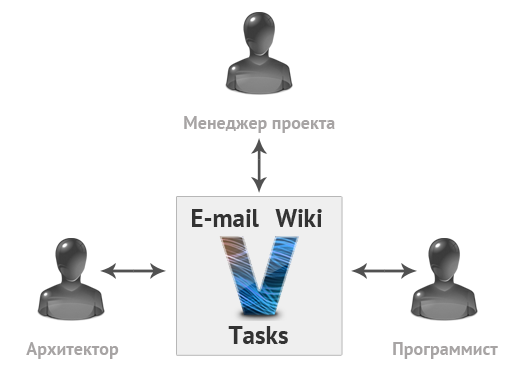
Volna replaces the knowledge base, mail and task system
After completing the tasks, part of the correspondence is deleted, and only the important remains. Sections are labeled with headings and thus sections of documentation are created.
The team working in such a system receives:
- the ability to set tasks faster, because you need to make fewer descriptions;
- the knowledge gained in the process of solving the problem is not lost, but written into the documentation;
How we set tasks
Now we do not share the system of knowledge, messages and problem statement. In order to set a task, we simply write the word “task” in the context in brackets, the system processes the expression and notifies the performer.Let's tell an example from the history of writing this article. We made a sketch of the illustrations for the “Air Tax” situation,
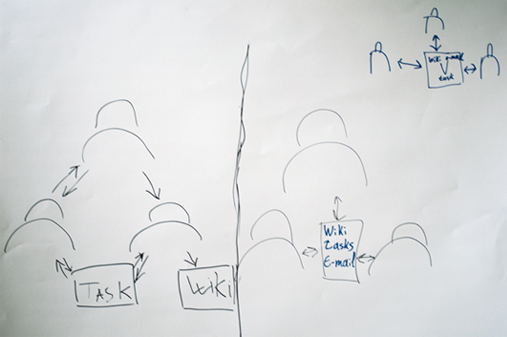
thoughts about future illustration on paper
made a short text description and set the designer a task: “make a sketch (task Sasha)”. After that, they continued to work.
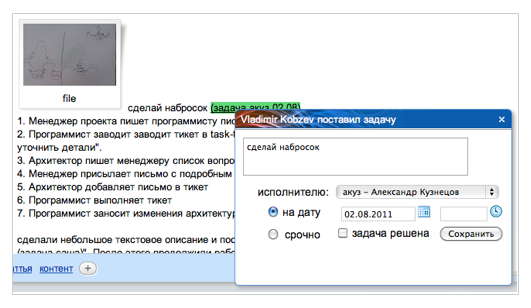
task setting interface
Sasha: “When I took on the task, the guys had already decided on other pictures, and I began to think through their overall design. I drew and pasted an illustration into the article. Colleagues at this time continued to write and then set the task for revision. This time we managed in 2 iterations :) ”.
We work with tasks in TaskGadget:
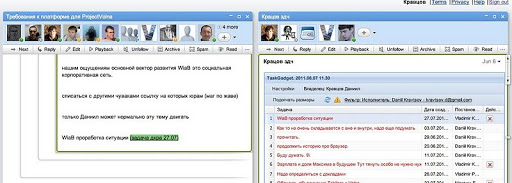
TaskGadget for contextual tasks
Each task in the list contains a link to the transition to the context.
Now the solution is based on the Google Wave (GW) platform, to which we wrote an extension and robots. In the future, we plan to migrate all our tools to WiaB, a platform developed by the Apache consortium and the future heir of GW.
Upd: Many ask questions about the fate and closing date of GW. Representatives of Google say that we put on a dead horse. But in spite of this, they promise that GW will work until alternative sites appear ready to accept users.
Discussions and working with documentation
In the process of working on packaging, we have left such documentation ,which, in the future, you can re-read from the headlines, and gradually dive into the desired context.
We call it Zoom reading.
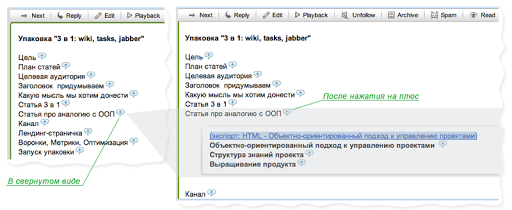
zoom reading
We tried to implement this concept based on an extension for Google Chrome . And in the future we will develop it on other platforms.
It is necessary to add that this article appeared largely due to people who believe in our project and help us:

list of article editors
We offer to try our methodology .
Source: https://habr.com/ru/post/126125/
All Articles